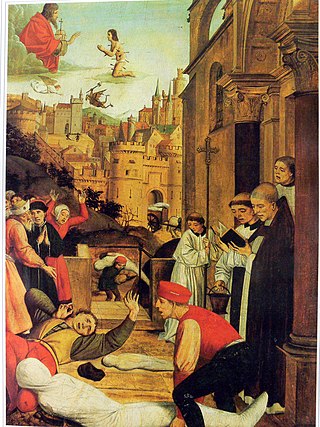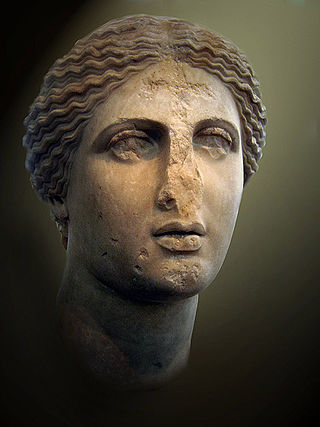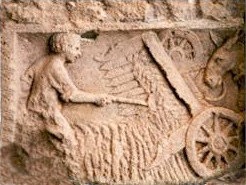Related Research Articles

Hadrian was Roman emperor from 117 to 138. Hadrian was born in Italica, close to modern Seville in Spain, an Italic settlement in Hispania Baetica; his branch of the Aelia gens, the Aeli Hadriani, came from the town of Hadria in eastern Italy. He was a member of the Nerva-Antonine dynasty.

The Roman Empire was the state ruled by the Romans following Octavian's assumption of sole rule under the Principate in 27 BC, the post-Republican state of ancient Rome. It included territories in Europe, North Africa, and Western Asia and was ruled by emperors. The fall of the Western Roman Empire in 476 AD conventionally marks the end of classical antiquity and the beginning of the Middle Ages.

Jovian was Roman emperor from June 363 to February 364. As part of the imperial bodyguard, he accompanied Julian on his campaign against the Sasanian Empire. Julian was killed in battle, and the exhausted and ill-provisioned army declared Jovian his successor. Unable to cross the Tigris, Jovian made peace with the Sasanids on humiliating terms. He spent the rest of his seven-month reign traveling back to Constantinople. After his arrival at Edessa, Jovian was petitioned by bishops over doctrinal issues concerning Christianity. Albeit the last emperor to rule the whole Empire during his entire reign, he died at Dadastana, never having reached the capital.
Theodore of Tarsus was Archbishop of Canterbury from 668 to 690. Theodore grew up in Tarsus, but fled to Constantinople after the Persian Empire conquered Tarsus and other cities. After studying there, he relocated to Rome and was later installed as the Archbishop of Canterbury on the orders of Pope Vitalian. Accounts of his life appear in two 8th-century texts. Theodore is best known for his reform of the English Church and establishment of a school in Canterbury.

The plague of Justinian or Justinianic plague was an epidemic that afflicted the entire Mediterranean Basin, Europe, and the Near East, severely affecting the Sasanian Empire and the Byzantine Empire, especially Constantinople. The plague is named for the Byzantine Emperor Justinian I, who according to his court historian Procopius contracted the disease and recovered in 542, at the height of the epidemic which killed about a fifth of the population in the imperial capital. The contagion arrived in Roman Egypt in 541, spread around the Mediterranean Sea until 544, and persisted in Northern Europe and the Arabian Peninsula until 549. By 543, the plague had spread to every corner of the empire. As the first episode of the first plague pandemic, it had profound economic, social, and political effects across Europe and the Near East and cultural and religious impact on Eastern Roman society.

The Second Sophistic is a literary-historical term referring to the Greek writers who flourished from the reign of Nero until c. 230 AD and who were catalogued and celebrated by Philostratus in his Lives of the Sophists. However, some recent research has indicated that this Second Sophistic, which was previously thought to have very suddenly and abruptly appeared in the late 1st century, actually had its roots in the early 1st century. It was followed in the 5th century by the philosophy of Byzantine rhetoric, sometimes referred to as the Third Sophistic.

The cursus publicus was the state mandated and supervised courier and transportation service of the Roman Empire, whose use continued into the Eastern Roman Empire. It was a system based on obligations placed on private persons by the Roman State. As contractors, called mancipes, they provided the equipment, animals, and wagons. In the Early Empire compensation had to be paid but this had fallen into abeyance in Late Antiquity when maintenance was charged to the inhabitants along the routes. The service contained only those personnel necessary for administration and operation. These included veterinarians, wagon-wrights, and grooms. The couriers and wagon drivers did not belong to the service: whether public servants or private individuals, they used facilities requisitioned from local individuals and communities. The costs in Late Antiquity were charged to the provincials as part of the provincial tax obligations in the form of a liturgy/munus on private individual taxpayers.

Marriage in ancient Rome was a fundamental institution of society and was used by Romans primarily as a tool for interfamilial alliances. The institution of Roman marriage was a practice of marital monogamy: Roman citizens could have only one spouse at a time in marriage but were allowed to divorce and remarry. This form of prescriptively monogamous marriage that co-existed with male resource polygyny in Greco-Roman civilization may have arisen from the relative egalitarianism of democratic and republican city-states. Early Christianity embraced this ideal of monogamous marriage by adding its own teaching of sexual monogamy, and perpetrated it worldwide and became as an essential element in many later Western cultures.

Homosexuality in ancient Rome often differs markedly from the contemporary West. Latin lacks words that would precisely translate "homosexual" and "heterosexual". The primary dichotomy of ancient Roman sexuality was active / dominant / masculine and passive / submissive / feminine. Roman society was patriarchal, and the freeborn male citizen possessed political liberty (libertas) and the right to rule both himself and his household (familia). "Virtue" (virtus) was seen as an active quality through which a man (vir) defined himself. The conquest mentality and "cult of virility" shaped same-sex relations. Roman men were free to enjoy sex with other males without a perceived loss of masculinity or social status as long as they took the dominant or penetrative role. Acceptable male partners were slaves and former slaves, prostitutes, and entertainers, whose lifestyle placed them in the nebulous social realm of infamia, so they were excluded from the normal protections accorded to a citizen even if they were technically free. Freeborn male minors were off limits at certain periods in Rome.

The growth of Christianity from its obscure origin c. 40 AD, with fewer than 1,000 followers, to being the majority religion of the entire Roman Empire by AD 400, has been examined through a wide variety of historiographical approaches.

The Byzantine Empire, also referred to as the Eastern Roman Empire, was the continuation of the Roman Empire centered in Constantinople during Late Antiquity and the Middle Ages. The eastern half of the Empire survived the conditions that caused the fall of the West in the 5th century AD, and continued to exist until the fall of Constantinople to the Ottoman Empire in 1453. During most of its existence, the empire remained the most powerful economic, cultural, and military force in the Mediterranean world. The term "Byzantine Empire" was only coined following the empire's demise; its citizens referred to the polity as the "Roman Empire" and to themselves as "Romans". Due to the imperial seat's move from Rome to Byzantium, the adoption of state Christianity, and the predominance of Greek instead of Latin, modern historians continue to make a distinction between the earlier Roman Empire and the later Byzantine Empire.
Annia Fundania Faustina was a noble Roman woman who lived in the Roman Empire during the 2nd century AD. She was the paternal cousin of Roman Emperor Marcus Aurelius and his sister Annia Cornificia Faustina.

Persecution of pagans in the late Roman Empire began during the reign of Constantine the Great in the military colony of Aelia Capitolina (Jerusalem), when he destroyed a pagan temple for the purpose of constructing a Christian church. Rome had periodically confiscated church properties, and Constantine was vigorous in reclaiming them whenever these issues were brought to his attention. Christian historians alleged that Hadrian had constructed a temple to Venus on the site of the crucifixion of Jesus on Golgotha hill in order to suppress Christian veneration there. Constantine used that to justify the temple's destruction, saying he was simply reclaiming the property. Using the vocabulary of reclamation, Constantine acquired several more sites of Christian significance in the Holy Land.

Israel the Grammarian was one of the leading European scholars of the mid-tenth century. In the 930s, he was at the court of King Æthelstan of England (r. 924–39). After Æthelstan's death, Israel successfully sought the patronage of Archbishop Rotbert of Trier and became tutor to Bruno, later the Archbishop of Cologne. In the late 940s Israel is recorded as a bishop, and at the end of his life he was a monk at the Benedictine monastery of Saint-Maximin in Trier.

Christianization of the Roman Empire as diffusion of innovation looks at religious change in the Roman Empire's first three centuries through the lens of diffusion of innovations, a sociological theory popularized by Everett Rogers in 1962. Diffusion of innovation is a process of communication that takes place over time, among those within a social system, that explains how, why, and when new ideas spread. In this theory, an innovation's success or failure is dependent upon the characteristics of the innovation itself, the adopters, what communication channels are used, time, and the social system in which it all happens.
In Ancient Rome, there were four primary kinds of taxation: a cattle tax, a land tax, customs, and a tax on the profits of any profession. These taxes were typically collected by local aristocrats. The Roman state would set a fixed amount of money each region needed to provide in taxes, and the local officials would decide who paid the taxes and how much they paid. Once collected the taxes would be used to fund the military, create public works, establish trade networks, stimulate the economy, and to fund the cursus publicum.

The Tributum soli was a direct ancient Roman tax on agricultural land and possibly the equipment used to cultivate the land. The size of tax was determined based on the size and quality of the land, and the land was assessed using a census. Greek cities during the Roman Empire would appoint magistrates, usually called dekaprotoi. During the Roman Empire the Tributum soli was split into two taxes, the stipendium and the Tributum soli. The difference between the two was that the stipendium was used in senatorial provinces, while the Tributum was used in imperial provinces. In some areas it was a fixed sum paid in currency. It was paid in kind and collected by the publicani in other provinces.

The ancient Romans had a variety of toys and games. Children used toys such as tops, marbles, wooden swords, kites, whips, seesaws, dolls, chariots, and swings. Gambling and betting were popular games in ancient Rome. Legislation heavily regulated gambling; however, these laws were likely not enforced. Tali, Terni lapilli, Duodecim Scripta, and Ludus latrunculorum were all popular games in ancient Rome. They were similar to poker, tic-tac-toe, backgammon, and chess respectively. Nine men's morris may also have been a popular game in ancient Rome. Roman children also played games simulating historical battles and could pretend to be important government officials.
The Lex Cornelia de sicariis et veneficis was a Roman statute enacted by Lucius Cornelius Sulla in 81 BC during his dictatorship to write laws and reconstitute the state which aimed at the punishment of murderers, poisoners, abortionists, human sacrifice, and malign magicians and was later also applied to the punishment of castration and circumcision. It was still in force in the time of Justinian in the 6th century A.D.
References
- ↑ McLynn 2009, pp. 482–483.
- ↑ MacMullen 2019, p. 192.
- ↑ Peachin 2011, p. 153.
- ↑ Ville Vuolanto, "Selling a Freeborn Child: Rhetoric and Social Realities in the Late Roman World," Ancient Society 33 (2003), p. 191.
- ↑ Perkins 2008, p. 5-6.
- ↑ Duff 2001, p. 18-21.
- ↑ Rohmann 2012, p. 1.
- ↑ Grubbs 2002, p. 10.
- ↑ Grubbs 2002, p. 12.
- ↑ Berger 2002, p. 490.
- ↑ Lapidge 2018, p. 24-29.
- ↑ Fleiner 2020.
- ↑ Sarris 2011, p. 29.
- ↑ Peachin 2011, p. 153–154, 475.
- ↑ Duff 2017, p. 173.
Bibliography
- Berger, Adolf (2002). Encyclopedic Dictionary of Roman Law. The Lawbook Exchange, Ltd. ISBN 978-1-58477-142-5.
- Duff, Paul B. (2017-11-21). Jesus Followers in the Roman Empire. Wm. B. Eerdmans Publishing. ISBN 978-1-4674-4838-3.
- Duff, Paul B. (2001). Who Rides the Beast?: Prophetic Rivalry and the Rhetoric of Crisis in the Churches of the Apocalypse. Oxford University Press. ISBN 978-0-19-513835-1.
- Fleiner, Carey (2020-02-28). A writer's guide to Ancient Rome. Manchester University Press. ISBN 978-1-5261-3525-4.
- Grubbs, Judith A. (2002). Women and the Law in the Roman Empire: A Sourcebook on Marriage, Divorce and Widowhood. Psychology Press. ISBN 978-0-415-15240-2.
- Lapidge, Michael (2018). The Roman Martyrs: Introduction, Translations, and Commentary. Oxford University Press. ISBN 978-0-19-881136-7.
- Rohmann, Dirk (2012-10-26), Bagnall, Roger S; Brodersen, Kai; Champion, Craige B; Erskine, Andrew (eds.), The Encyclopedia of Ancient History, Hoboken, NJ, USA: John Wiley & Sons, Inc., pp. wbeah22157, doi:10.1002/9781444338386.wbeah22157, ISBN 978-1-4443-3838-6 , retrieved 2022-10-08
- Sarris, Peter (2011-10-27). Empires of Faith: The Fall of Rome to the Rise of Islam, 500-700. OUP Oxford. ISBN 978-0-19-162002-7.
- Matyszak, Philip (2014-04-03). The Roman Empire: A Beginner's Guide. Simon and Schuster. ISBN 978-1-78074-425-4.
- MacMullen, Ramsay (2019-02-19). Changes in the Roman Empire: Essays in the Ordinary. Princeton University Press. ISBN 978-0-691-19805-7.
- McLynn, Frank (2009-08-11). Marcus Aurelius: A Life. Da Capo Press. ISBN 978-0-306-81830-1.
- Peachin, Michael (2011). The Oxford Handbook of Social Relations in the Roman World. Oxford University Press. ISBN 978-0-19-518800-4.
- Perkins, Judith (2008-08-22). Roman Imperial Identities in the Early Christian Era. Routledge. ISBN 978-1-134-15264-3.